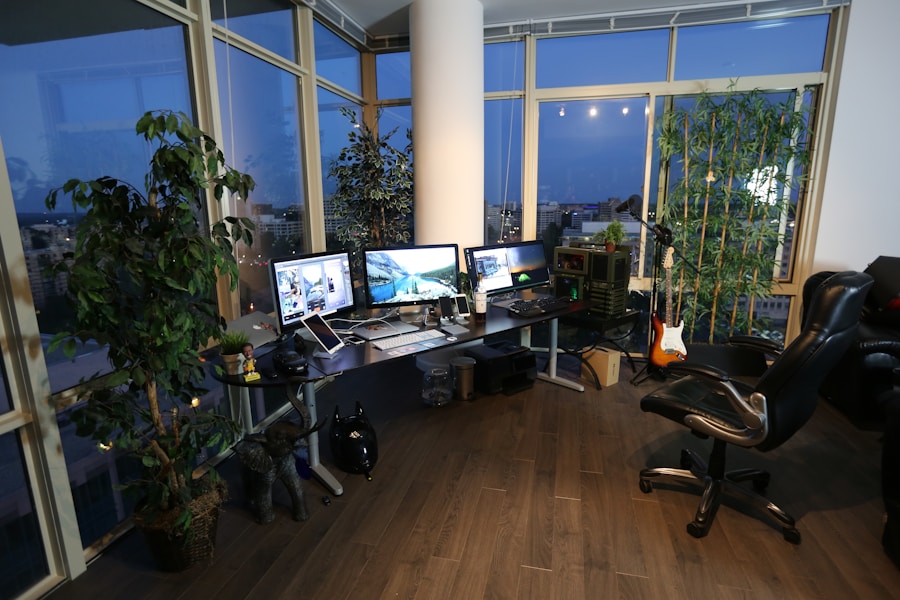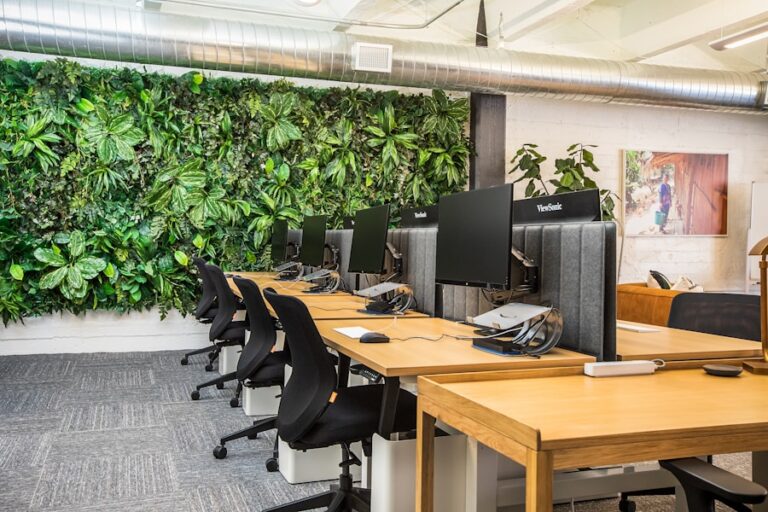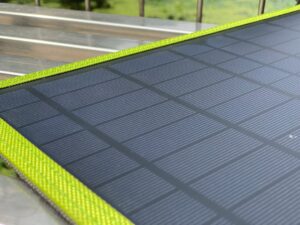Biophilic office design is an innovative approach that seeks to integrate natural elements into the workplace, fostering a connection between employees and the environment. This design philosophy is rooted in the concept of biophilia, which suggests that humans have an innate affinity for nature. As urbanization continues to rise and people spend more time indoors, the need for biophilic design has become increasingly relevant.
By incorporating natural elements into office spaces, organizations can create environments that not only enhance aesthetic appeal but also promote well-being and productivity among employees. The significance of biophilic design extends beyond mere aesthetics; it encompasses a holistic approach to creating workspaces that nurture both the mind and body. As companies strive to attract and retain talent, the design of the workplace has emerged as a critical factor in employee satisfaction.
Biophilic design offers a solution by transforming sterile office environments into vibrant spaces that reflect the beauty of nature. This transformation can lead to improved morale, reduced stress levels, and increased creativity, ultimately benefiting both employees and employers alike.
Key Takeaways
- Biophilic office design incorporates natural elements to create a more productive and healthy work environment.
- Nature in the workplace has been shown to have psychological and physiological benefits for employees, including reduced stress and improved focus.
- Implementing biophilic design elements in the office space can include adding natural materials, textures, and greenery to create a more natural and calming environment.
- Natural light and air quality play a crucial role in biophilic design, as they can improve mood, energy levels, and overall well-being for employees.
- Incorporating plants and greenery in the office environment can help reduce stress, increase productivity, and improve air quality.
The Psychological and Physiological Benefits of Nature in the Workplace
The psychological benefits of incorporating nature into the workplace are profound. Research has shown that exposure to natural elements can significantly reduce stress and anxiety levels among employees. When individuals are surrounded by greenery or natural light, they often experience a sense of calm and relaxation, which can enhance their overall mood.
This positive emotional state can lead to increased job satisfaction and a greater sense of belonging within the organization. Physiologically, the presence of nature in the workplace has been linked to various health benefits. Studies indicate that employees who work in biophilic environments tend to have lower blood pressure, improved immune function, and reduced fatigue.
These health improvements can lead to fewer sick days and lower healthcare costs for employers. Furthermore, the incorporation of natural elements can enhance cognitive function, leading to better focus and productivity. By understanding these benefits, organizations can make informed decisions about how to design their workspaces to support employee health and well-being.
Implementing Biophilic Design Elements in the Office Space

Implementing biophilic design elements in an office space requires a thoughtful approach that considers both aesthetics and functionality. One effective strategy is to create open layouts that allow for the seamless integration of natural elements. This can include large windows that provide views of the outdoors, as well as open spaces that encourage collaboration and interaction among employees.
By designing spaces that prioritize connectivity with nature, organizations can foster a sense of community while enhancing the overall work experience. In addition to layout considerations, incorporating specific design elements such as water features, living walls, and natural materials can further enhance the biophilic experience. Water features, such as fountains or aquariums, can create soothing sounds that promote relaxation and focus.
Living walls, adorned with a variety of plants, not only improve air quality but also serve as stunning visual focal points within the office. Natural materials like wood, stone, and bamboo can be used in furniture and decor to evoke a sense of warmth and connection to the earth. By thoughtfully integrating these elements, organizations can create a harmonious balance between nature and the built environment.
The Role of Natural Light and Air Quality in Biophilic Design
| Metrics | Value |
|---|---|
| Percentage of natural light in biophilic design | 70% |
| Indoor air quality improvement with biophilic design | 15% |
| Productivity increase with natural light exposure | 10-15% |
| Reduction in sick days with improved air quality | 20% |
Natural light plays a pivotal role in biophilic office design, significantly impacting employee well-being and productivity. Access to natural light has been shown to improve mood, enhance alertness, and regulate circadian rhythms. Offices designed with ample windows or skylights allow sunlight to flood the space, creating a vibrant atmosphere that energizes employees throughout the day.
Moreover, exposure to natural light can reduce reliance on artificial lighting, leading to energy savings for organizations. Air quality is another critical component of biophilic design that cannot be overlooked. Poor indoor air quality can lead to a range of health issues, including respiratory problems and decreased cognitive function.
To promote better air quality in the workplace, organizations can incorporate ventilation systems that bring in fresh outdoor air and utilize air-purifying plants that naturally filter toxins from the environment. By prioritizing both natural light and air quality, companies can create healthier workspaces that support employee well-being and productivity.
Incorporating Plants and Greenery in the Office Environment
The incorporation of plants and greenery into office environments is one of the most recognizable aspects of biophilic design. Plants not only enhance the aesthetic appeal of a workspace but also provide numerous health benefits. Research has demonstrated that having plants in the office can improve air quality by absorbing carbon dioxide and releasing oxygen.
Additionally, plants have been shown to reduce stress levels and increase feelings of happiness among employees. To effectively incorporate greenery into office spaces, organizations can consider various strategies such as creating designated plant zones or using vertical gardens. Desk plants can also be encouraged as personal touches that allow employees to connect with nature on an individual level.
Furthermore, selecting low-maintenance plants ensures that greenery remains vibrant without requiring excessive care. By embracing plants as integral components of office design, organizations can cultivate environments that promote health, creativity, and overall well-being.
Using Natural Materials and Textures for a Biophilic Office Design

The use of natural materials and textures is essential in creating a biophilic office design that resonates with employees on multiple sensory levels. Materials such as wood, stone, and clay evoke a sense of warmth and authenticity that artificial materials often lack. Incorporating these elements into furniture, flooring, and wall finishes can create a tactile experience that enhances comfort and connection to nature.
In addition to visual appeal, natural textures contribute to a calming atmosphere within the workplace. For instance, wooden surfaces can provide a sense of grounding while soft textiles can add warmth and coziness to communal areas. By thoughtfully selecting materials that reflect the beauty of nature, organizations can create spaces that not only look inviting but also feel welcoming.
This attention to detail fosters an environment where employees feel more at ease and inspired to perform at their best.
Creating Biophilic Workspaces to Promote Employee Well-being and Productivity
Creating biophilic workspaces goes beyond simply adding plants or natural light; it involves designing environments that prioritize employee well-being and productivity holistically. This can be achieved by incorporating flexible workspaces that allow employees to choose where they feel most comfortable working—whether it be in a quiet nook surrounded by greenery or an open area filled with natural light. Moreover, integrating spaces for relaxation and social interaction is crucial for promoting mental health within the workplace.
Breakout areas adorned with comfortable seating and natural elements provide employees with opportunities to recharge during their workday. By fostering a culture that values well-being through thoughtful design choices, organizations can cultivate an atmosphere where employees feel valued and motivated to contribute their best efforts.
Case Studies and Examples of Successful Biophilic Office Designs
Numerous organizations have successfully embraced biophilic design principles in their office spaces, showcasing the transformative power of nature in the workplace. One notable example is Amazon’s Spheres in Seattle, which features three glass domes filled with thousands of plants from around the world. This unique space serves as both an office environment and a botanical garden, providing employees with an immersive experience that fosters creativity and collaboration.
Another inspiring case is the Edge in Amsterdam, known for its innovative use of natural light and greenery throughout its design. The building incorporates extensive glass facades that maximize sunlight exposure while also featuring numerous indoor gardens. Employees at the Edge benefit from enhanced air quality and access to nature-inspired spaces that promote well-being.
These case studies illustrate how biophilic design can be effectively implemented in diverse settings, resulting in workplaces that prioritize employee health while enhancing productivity. As more organizations recognize the importance of connecting with nature within their office environments, biophilic design will continue to shape the future of workspaces around the globe.
Biophilic office design has been gaining popularity in recent years as companies recognize the benefits of incorporating nature into the workplace. According to a recent article on Candybird, creating a cozy living room with paint can also have a positive impact on productivity and well-being. By using warm, inviting colors and natural elements, employees can feel more comfortable and relaxed in their work environment. To learn more about how to create a cozy living room with paint, check out the step-by-step guide here.
FAQs
What is biophilic office design?
Biophilic office design is an approach to creating workspaces that incorporate natural elements, such as plants, natural light, and views of nature, to improve the well-being and productivity of employees.
What are the benefits of biophilic office design?
Biophilic office design has been shown to reduce stress, improve air quality, increase productivity, creativity, and overall well-being of employees. It also helps in reducing absenteeism and improving employee retention.
How can biophilic office design be implemented?
Biophilic office design can be implemented by incorporating natural elements such as plants, natural materials, and water features into the office space. It can also involve maximizing natural light, providing views of nature, and creating spaces for employees to connect with nature.
Are there any specific guidelines for biophilic office design?
There are no strict guidelines for biophilic office design, but it is generally recommended to incorporate a variety of natural elements, provide access to natural light and views of nature, and create spaces for employees to connect with nature.
Does biophilic office design have an impact on the environment?
Biophilic office design can have a positive impact on the environment by promoting the use of sustainable materials, reducing energy consumption through natural lighting and ventilation, and improving indoor air quality through the use of plants.






